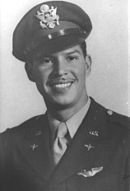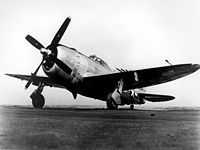- Oscar F. Perdomo
-
Oscar Francis Perdomo 
1st Lt. Oscar Francis Perdomo
Last "Ace in a day" for the United States in World War IIBorn July 14, 1919
El Paso, TexasDied March 2, 1978 (aged 58)
Los Angeles, CaliforniaAllegiance United States of America Service/branch  United States Army Air Force
United States Army Air Force
 United States Air Force
United States Air ForceYears of service 1943-1947 (USAAF)
1947-1950, 1952-1958 (USAF)Rank 
MajorUnit 464th Fighter Squadron Battles/wars World War II
Korean WarAwards Distinguished Service Cross
Air Medal with oak leaf clusterMajor Oscar Francis Perdomo (July 14, 1919–March 2, 1976), a recipient of the Distinguished Service Cross, was a United States Air Force officer who was the last “Ace in a day” for the United States in World War II.
Contents
Early years
Perdomo, a Mexican American, was one of five siblings born in El Paso, Texas to Mexican immigrants. His father served in the Mexican Revolution under the command of Francisco "Pancho" Villa before emigrating to the United States.
Military service
In February 1943, Perdomo entered an Army Air Forces (AAF) Pilot School in Chandler, Arizona. The AAF schools were civilian flying schools, under government contract, which provided a considerable part of the flying training effort undertaken during World War II by the Army Air Forces. Perdomo received his "wings" on January 7, 1944. He was then sent to the Army Air Forces Basic Flight School at Chico, California, where he underwent further training as a Republic P-47 Thunderbolt pilot. Upon the completion of his training he was assigned to the 464th Fighter Squadron which was part of the 507th Fighter Group that was sent overseas to the Pacific theater to the Island of Ie Shima off the west coast of Okinawa. The primary mission of the 507th was to provide fighter cover to 8th Air Force Boeing B-29's which were to be stationed on Okinawa.[1]
The 507th began operations on July 1, 1945. Perdomo was assigned P-47N-2-RE number 146 aircraft (serial number 44-88211), maintained by crew chief S/Sgt. F. W. Pozieky. Perdomo nicknamed his airplane Lil Meaties Meat Chopper with the nose art depicting a diapered baby chomping a cigar in his mouth and derby hat on his head, clutching a rifle. The name referred to his first son, Kenneth, then a year and a half old. Perdomo flew his first combat mission on July 2, while escorting a B-29 to Kyushu.
Ace in a Day
A “flying ace” or fighter ace is a military aviator credited with shooting down five or more enemy aircraft during aerial combat. The term “ace in a day” is used to designate a fighter pilot who has shot down five or more airplanes in a single day. Since World War I, a number of pilots have been honored as “Ace in a Day”. The last “Ace in a Day” for the United States in World War II was 1st Lt. Oscar Francis Perdomo.[2]
Perdomo was a first lieutenant and a veteran of ten combat missions when on August 9, 1945 the United States dropped the world's second atomic bomb on Nagasaki, Japan. The allies were still awaiting Japan’s response to the demand to surrender and the war continued, when on August 13, 1945 1st Lt. Perdomo, shot down four Nakajima “Oscar” fighters and one Yokosuka “Willow” Type 93 biplane trainer. This action took place near Keijo/Seoul, Korea when 38 Thunderbolts of the 507th Fighter Wing, USAAF, encountered approximately 50 enemy aircraft. It was Perdomo's last combat mission, and the five confirmed victories made him an “Ace in a Day” and thus the distinction of being the last “Ace” of the United States in World War II. He was awarded the Distinguished Service Cross and the Air Medal with one leaf cluster.[3]
Post World War II
After the war, Perdomo continued to serve in the Army Air Force. In 1947, he was reassigned to the newly formed United States Air Force and served until January 1950. When Perdomo returned to civilian life, he joined the Air Force Reserve. On June 30, 1950, Perdomo was recalled to active duty upon the outbreak of the Korean War at the rank of Captain. He continued to serve in the Air Force until January 30, 1958 when he left the military at the rank of Major.[4]
Later years
Perdomo was emotionally affected when his son, SPc4 Kris Mitchell Perdomo, was one of 3 men killed on May 5, 1970, aboard a U.S. Army helicopter UH-1 Iroquois which crashed and exploded about 5 miles southwest of the city of Phy Vinh in Vinh Binh Province, South Vietnam.[5] He had trouble coping with the situation and developed an addiction to alcohol, which took Major Oscar F. Perdomo's life on March 2, 1976.[6] He was proclaimed dead upon his arrival at USC Medical Center, Los Angeles, California. His name is inscribed in the United States Air Force Memorial.[7]
Military decorations and awards
Major Oscar F. Perdomo's military decorations include the following:
 Distinguished Service Cross
Distinguished Service Cross Silver Star
Silver Star Air Medal with one cluster
Air Medal with one cluster American Campaign Medal
American Campaign Medal Asiatic-Pacific Campaign Medal
Asiatic-Pacific Campaign Medal World War II Victory Medal
World War II Victory Medal National Defense Service Medal
National Defense Service Medal Korean Service Medal
Korean Service Medal United Nations Service Medal
United Nations Service Medal Republic of Korea Presidential Unit Citation.
Republic of Korea Presidential Unit Citation.
Badges:
See also
- Hispanic Americans in World War II
- List of World War II aces from United States
- Hispanics in the United States Air Force
References
Categories:- 1919 births
- 1976 deaths
- Recipients of the Distinguished Service Cross (United States)
- Recipients of the Silver Star
- American military personnel of the Korean War
- American people of Mexican descent
- American World War II flying aces
- United States Air Force officers
- Recipients of the Air Medal
- United States Army Air Forces pilots of World War II
- United States Army Air Forces officers
Wikimedia Foundation. 2010.


